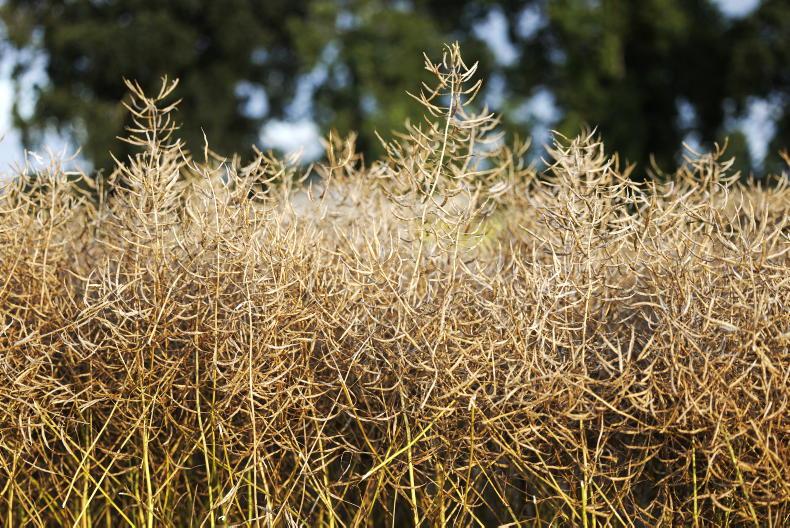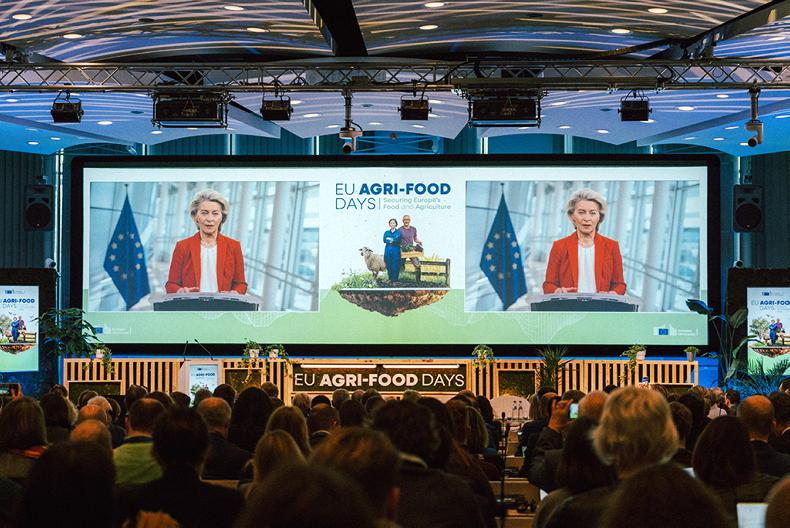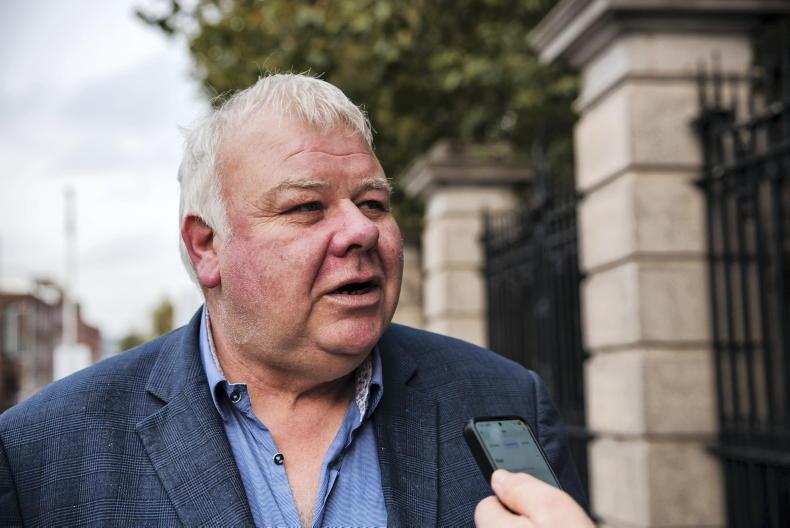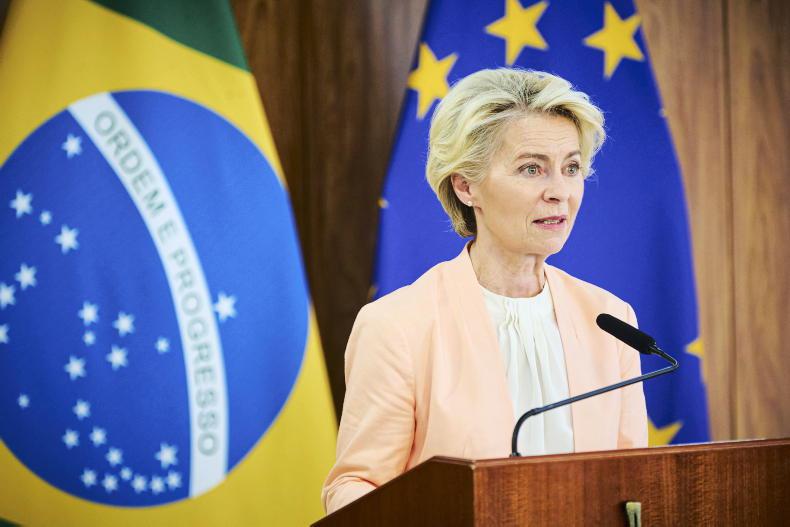Decisions made in the European Parliament over the coming months will determine exactly how severely the EU’s Farm to Fork policy will affect farmers in Ireland right up to 2050.
The impact on farmers of already agreed EU environmental targets will come down to the details of the definitions and benchmarks to be agreed to assess their progress, Fine Gael MEP for the Midlands-Northwest Colm Markey told the Irish Farmers Journal.
Farmers are faced with a revision of the industrial emissions directive, a sustainable use of pesticides regulation and a new nature restoration law. All are currently being debated and amended in the European Parliament.
Member states will have to come up with some of their own definitions on EU green policies but the key parameters will be set out in the Parliament.
Not all MEPs are looking to ease the burden of all these new rules on farmers, Markey warned.
The Commission’s plans to enact a nature restoration law seeks to put environmental measures in place across 90% of the EU’s ecosystems, including those which are actively farmed by 2050.
It has come under pressure from MEPs on both sides of the farmer-environmentalist coin.
Some MEPs argued that targets should not impact on food production, while others sought even higher targets than those initially proposed. The final position, expected over the coming months, will determine what exactly will be required from farmers on rewetting and how much land will fall under new designations.
Within this proposed law, peatland restoration targets will seek to restore 30% of boglands by 2030, rising to 70% by 2050.
“When it comes to nature restoration, the definitions will be key. We are talking about designating huge areas of land and it will really come down to what exactly the 30%, 50% and 70% will mean on the ground,” Markey explained.
“It is a designation and it will all depend on what will be enforced.”
The definitions which will determine whether the targets have been met are being negotiated at a time when food security is slipping down the agenda in Brussels again.
Markey claims that after coming to the fore after the invasion of Ukraine and rise in energy costs, food price and availability are once more an afterthought in negotiations on new environmental rules with the potential to restrict output. “Food security only becomes an issue when the prices get higher.
“When prices are starting to drop back a bit, it’s slipping off the agenda again, which is a concern.
“There are no guarantees on food security in the long-term between environmental restrictions and costs.”
The baseline figures used to assess how much progress has been made towards environmental targets could become a battleground.
Markey gave the example of spray reduction targets where official figures show that Ireland’s farmers only used 76% of the average volumes they used from 2015-2017 – the years used as the baseline for the Farm to Fork, as things stand.
One thing that is critically important is that we do not move the base years
However, he maintains that the EU could come under pressure to revise this target, which would mean that some of the progress already made by Irish farmers would not be recognised as the “goalposts could be shifted”.
“One thing that is critically important is that we do not move the base years. If we do, we will not give credit to those who have already acted and that’s unfair,” he insisted.
Markey said that there are some MEPs also pushing for a harsher spray reduction target than that proposed by the Commission – a 50% pesticide reduction across the board by 2030, alongside a separate 50% cut for more harmful pesticides.
“It will be pushed on both sides.
“There will be a push for a higher ambition on one side and there will equally be ambition to put figures in place that are achievable,” the MEP continued.
Family farms but industrial rules
Environment ministers from across the EU agreed their position on the updating of the industrial emissions directive in March, giving some leeway from what the Commission had initially proposed.
The directive governs “polluters” across all sectors of the economy but presently in agriculture, it only applies to large pig and poultry units.
Any farm falling within the updated rules will require an environmental permit to operate and will have to put costly measures in place to reduce ammonia, methane and other pollutants from their farms.
The Commission was seeking to take cattle farms with 150 livestock units (LU) under the directive’s fold. However, the ministers pushed this back to 350LU.
Markey told the Irish Farmers Journal that this figure is still too low as it includes family farms and that MEPs will seek to push this out further.
We need to recognise that a farm that’s more than six months at grass and a stocking rate of 2.5LU/ha should not be recognised as an industrial facility
“Family farms aren’t industrial farms,” he said.
The ministers agreed to give an exclusion to extensive grass-based farms from the rules, even if they have more than 350LU, but a 2LU/ha stocking rate limit would apply to this exemption from the rules.
“The figure is far too low – it is basically extensive grazing and nothing else. We need to recognise that a farm that’s more than six months at grass and a stocking rate of 2.5LU/ha should not be recognised as an industrial facility.”
Another issue with the Commission’s initial proposals that the MEP says should be resolved is the view that one LU would only be the equivalent of 3,000kg of milk and that higher yielding cows could represent more than a single LU.
“It is moving back to what we understand – at 3,000kg of milk it was only really half a cow to reach a livestock unit.”
Fertiliser price transparency
Markey spoke on the necessity of increasing price transparency in the fertiliser sector, saying the need grew as the Irish and EU prices gap widened earlier this year.
He pointed out that although Irish fertiliser prices have come back from the record highs quoted last year, Irish prices remain ahead of those being paid on the continent.
The European Commission is in the process of establishing a fertiliser market observatory group which will report on prices and expected movement.
Price updates
The expert group will provide real-time price updates and explain the factors affecting prices across the EU.
Similar observatories are already in place for key farm goods like milk, grain and fresh produce.
“We have seen it in the last couple of months where the lack of transparency in the market has left higher prices in Ireland,” Markey told the Irish Farmers Journal.
“I have been tracking the German price versus the Irish price for the last three months and we have been consistently a couple of hundred euros a tonne behind the Germans.
“Even when we saw some drops over the last few weeks, it’s still lagging behind in Ireland.”
Decisions made in the European Parliament over the coming months will determine exactly how severely the EU’s Farm to Fork policy will affect farmers in Ireland right up to 2050.
The impact on farmers of already agreed EU environmental targets will come down to the details of the definitions and benchmarks to be agreed to assess their progress, Fine Gael MEP for the Midlands-Northwest Colm Markey told the Irish Farmers Journal.
Farmers are faced with a revision of the industrial emissions directive, a sustainable use of pesticides regulation and a new nature restoration law. All are currently being debated and amended in the European Parliament.
Member states will have to come up with some of their own definitions on EU green policies but the key parameters will be set out in the Parliament.
Not all MEPs are looking to ease the burden of all these new rules on farmers, Markey warned.
The Commission’s plans to enact a nature restoration law seeks to put environmental measures in place across 90% of the EU’s ecosystems, including those which are actively farmed by 2050.
It has come under pressure from MEPs on both sides of the farmer-environmentalist coin.
Some MEPs argued that targets should not impact on food production, while others sought even higher targets than those initially proposed. The final position, expected over the coming months, will determine what exactly will be required from farmers on rewetting and how much land will fall under new designations.
Within this proposed law, peatland restoration targets will seek to restore 30% of boglands by 2030, rising to 70% by 2050.
“When it comes to nature restoration, the definitions will be key. We are talking about designating huge areas of land and it will really come down to what exactly the 30%, 50% and 70% will mean on the ground,” Markey explained.
“It is a designation and it will all depend on what will be enforced.”
The definitions which will determine whether the targets have been met are being negotiated at a time when food security is slipping down the agenda in Brussels again.
Markey claims that after coming to the fore after the invasion of Ukraine and rise in energy costs, food price and availability are once more an afterthought in negotiations on new environmental rules with the potential to restrict output. “Food security only becomes an issue when the prices get higher.
“When prices are starting to drop back a bit, it’s slipping off the agenda again, which is a concern.
“There are no guarantees on food security in the long-term between environmental restrictions and costs.”
The baseline figures used to assess how much progress has been made towards environmental targets could become a battleground.
Markey gave the example of spray reduction targets where official figures show that Ireland’s farmers only used 76% of the average volumes they used from 2015-2017 – the years used as the baseline for the Farm to Fork, as things stand.
One thing that is critically important is that we do not move the base years
However, he maintains that the EU could come under pressure to revise this target, which would mean that some of the progress already made by Irish farmers would not be recognised as the “goalposts could be shifted”.
“One thing that is critically important is that we do not move the base years. If we do, we will not give credit to those who have already acted and that’s unfair,” he insisted.
Markey said that there are some MEPs also pushing for a harsher spray reduction target than that proposed by the Commission – a 50% pesticide reduction across the board by 2030, alongside a separate 50% cut for more harmful pesticides.
“It will be pushed on both sides.
“There will be a push for a higher ambition on one side and there will equally be ambition to put figures in place that are achievable,” the MEP continued.
Family farms but industrial rules
Environment ministers from across the EU agreed their position on the updating of the industrial emissions directive in March, giving some leeway from what the Commission had initially proposed.
The directive governs “polluters” across all sectors of the economy but presently in agriculture, it only applies to large pig and poultry units.
Any farm falling within the updated rules will require an environmental permit to operate and will have to put costly measures in place to reduce ammonia, methane and other pollutants from their farms.
The Commission was seeking to take cattle farms with 150 livestock units (LU) under the directive’s fold. However, the ministers pushed this back to 350LU.
Markey told the Irish Farmers Journal that this figure is still too low as it includes family farms and that MEPs will seek to push this out further.
We need to recognise that a farm that’s more than six months at grass and a stocking rate of 2.5LU/ha should not be recognised as an industrial facility
“Family farms aren’t industrial farms,” he said.
The ministers agreed to give an exclusion to extensive grass-based farms from the rules, even if they have more than 350LU, but a 2LU/ha stocking rate limit would apply to this exemption from the rules.
“The figure is far too low – it is basically extensive grazing and nothing else. We need to recognise that a farm that’s more than six months at grass and a stocking rate of 2.5LU/ha should not be recognised as an industrial facility.”
Another issue with the Commission’s initial proposals that the MEP says should be resolved is the view that one LU would only be the equivalent of 3,000kg of milk and that higher yielding cows could represent more than a single LU.
“It is moving back to what we understand – at 3,000kg of milk it was only really half a cow to reach a livestock unit.”
Fertiliser price transparency
Markey spoke on the necessity of increasing price transparency in the fertiliser sector, saying the need grew as the Irish and EU prices gap widened earlier this year.
He pointed out that although Irish fertiliser prices have come back from the record highs quoted last year, Irish prices remain ahead of those being paid on the continent.
The European Commission is in the process of establishing a fertiliser market observatory group which will report on prices and expected movement.
Price updates
The expert group will provide real-time price updates and explain the factors affecting prices across the EU.
Similar observatories are already in place for key farm goods like milk, grain and fresh produce.
“We have seen it in the last couple of months where the lack of transparency in the market has left higher prices in Ireland,” Markey told the Irish Farmers Journal.
“I have been tracking the German price versus the Irish price for the last three months and we have been consistently a couple of hundred euros a tonne behind the Germans.
“Even when we saw some drops over the last few weeks, it’s still lagging behind in Ireland.”










SHARING OPTIONS